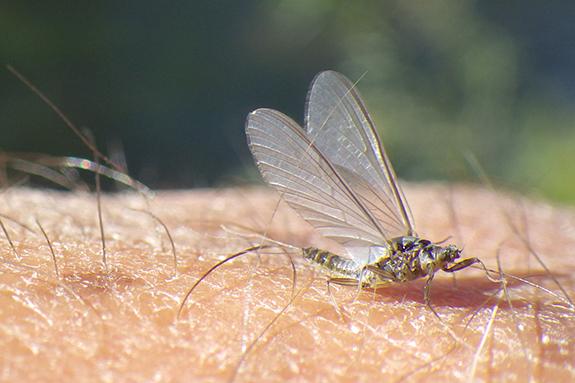While the inland trout season has six weeks remaining, the approach of closure does not mean there is less reason to fish. In fact there is a great reason to fish our Wisconsin trout streams at this time of season. One of the smallest mayflies, Tricorythodes, called Tricos by fishers, is still making its appearance in sufficient numbers to merit the attention of serious fishers. The reason this hatching of mayflies from trout streams is usually associated with experienced fishers is the challenge this hatch presents to those who pursue it.
Tricos are small in size, about 3/16 inches excluding their long three tails, but are significant enough in number to elicit pursuit by hungry trout. In appearance the female (as pictured) has a black head and thorax, olive abdomen that discloses the color of eggs held within her, cellophane clear wings and long tails. Males are similar but totally black in body color and smaller in the abdomen. A successful fly pattern will encompass these characteristics, especially for selective trout.
Knowing the behavior of Tricos will increase fishing success. Males, under cover of darkness, emerge from the rivers initiating the hatch and remain on stream-side vegetation waiting for first light. At dawn or shortly thereafter males take flight congregating into churning aerial swarms over streams. Females emerge in early morning and quickly molt and fly into the swarm and there mating occurs while flying. Females, carrying fertilized eggs in an olive colored ball at the tip of her abdomen, drop to the stream releasing eggs and sink beneath the surface. Males spent from mating also fall to the river, and like females, become caught in river currents that gather them in foam lines.
Thereby Tricos become a very attractive food source to trout. Trout at times will target single Trico mayflies floating or submerged, but frequently trout will swim up and focus their feeding on foam lines loaded with Tricos. The gulping behavior at surface or just below is the clue to this feeding practice.
As you likely expect fly patterns fished during a Trico hatch are very small, typically between #20 - #24 hook size. Depending on the trout feeding practice either a floating spent wing pattern or a submerged pattern will be the appropriate choice. When both feeding behaviors are observed, using both fly types tied in tandem to a very light weight tippet, e.g. 7X will be the correct choice.
In fact last week while fishing the Trico hatch on the South Platte River in Colorado this was the situation. Trout were taking those floating but mainly were taking sunken Tricos gathered by the current below surface. Their gulping behavior was evident at the surface as well as below surface.
When fishing with both fly types, both types caught trout; however, the sunken fly pattern was more commonly selected. The sinking feature of the fly design was accomplished by the addition of a micro-metal bead in the thorax of the fly, providing enough weight causing the fly to sink just below the stream surface.
The Trico hatch, a treasure offered by Central Wisconsin trout streams, is essentially a morning event but can extend past noon under cloudy skies and cooler temperatures. I think part of the attraction of this hatch is to test fly fishing skills honed over the previous summer months. Fishing very small flies with very thin diameter tippets that have breaking strength near three pounds is challenging and provides an exciting reward when successful. Consider fishing a fly pattern mimicking a mayfly 3/16 inches in length to catch and hold a trout of 15 inches resisting netting in the current of a river. Certainly the Trico hatch is a worthwhile experience.


